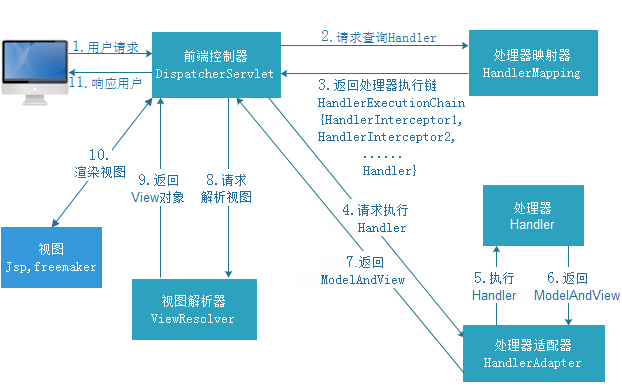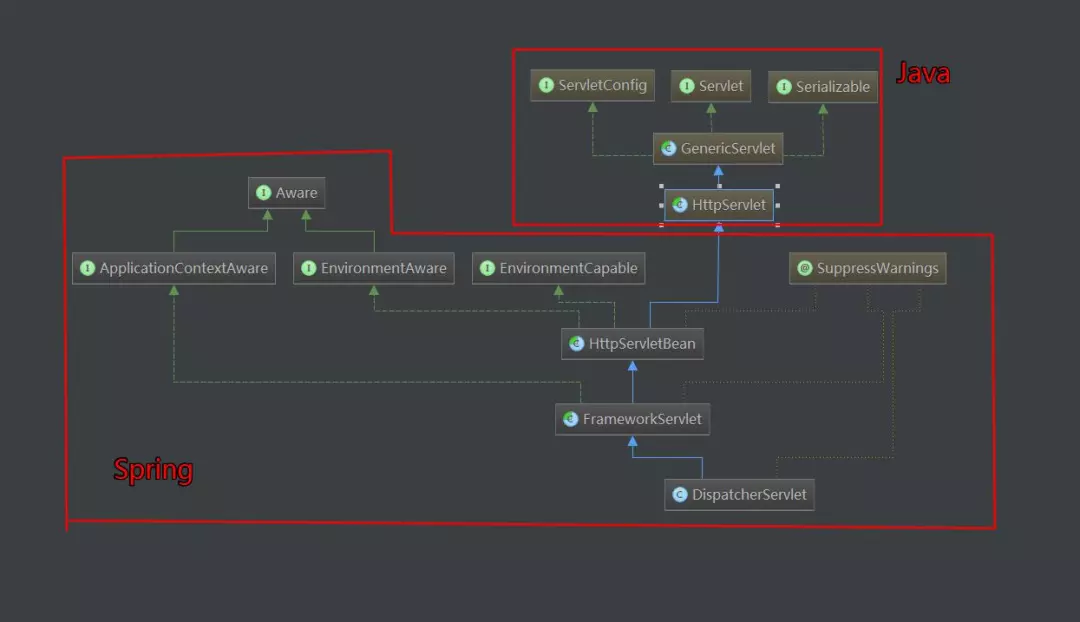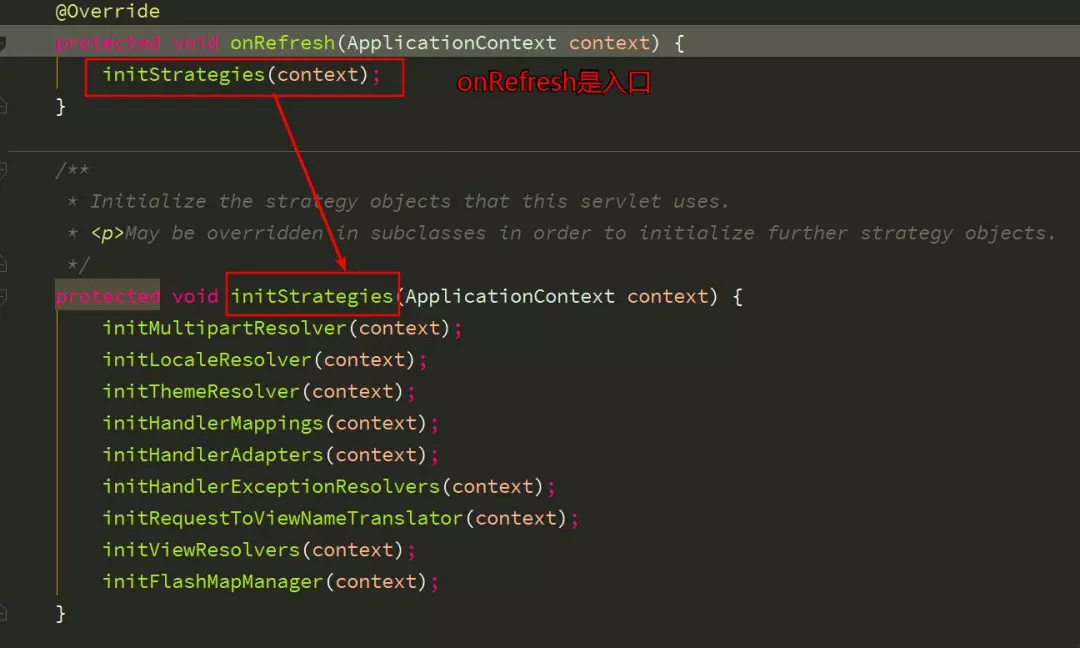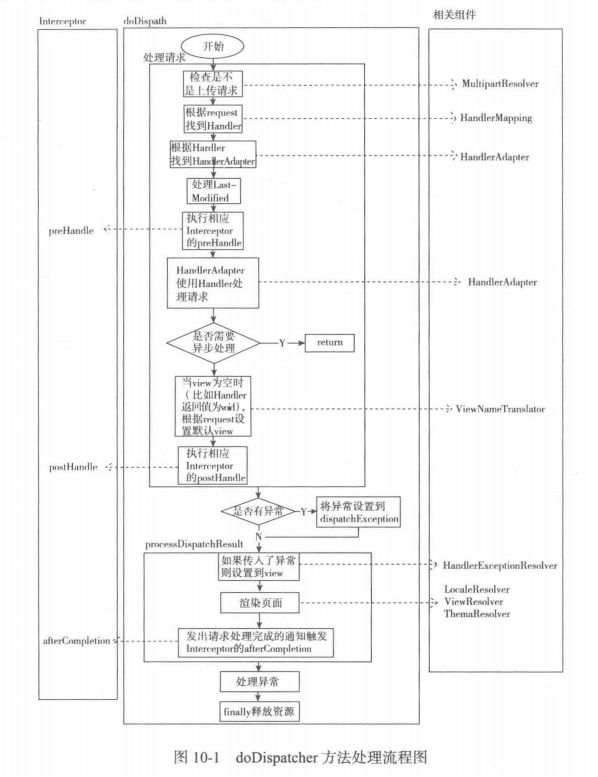
Spring MVC 之初体验
环境搭建
在 IDEA 中新建一个 web 项目,用 Maven 管理项目的话,在 pom.xml 中加入 Spring MVC 和 Servlet 依赖即可。
<!-- https://mvnrepository.com/artifact/org.springframework/spring-webmvc --> <dependency> <groupId>org.springframework</groupId> <artifactId>spring-webmvc</artifactId> <version>4.3.9.RELEASE</version> </dependency> <!-- https://mvnrepository.com/artifact/javax.servlet/javax.servlet-api --> <dependency> <groupId>javax.servlet</groupId> <artifactId>javax.servlet-api</artifactId> <version>3.1.0</version> <scope>provided</scope> </dependency>
Spring MVC 简单配置
在 web.xml 中配置 Servlet
创建 Spring MVC 的 xml 配置文件
创建 Controller 和 View
1、web.xml
<!-- Spring MVC配置 --> <!-- ====================================== --> <servlet> <servlet-name>spring</servlet-name> <servlet-class>org.springframework.web.servlet.DispatcherServlet</servlet-class> <!-- 可以自定义servlet.xml配置文件的位置和名称,默认为WEB-INF目录下,名称为[<servlet-name>]-servlet.xml,如spring-servlet.xml <init-param> <param-name>contextConfigLocation</param-name> <param-value>/WEB-INF/spring-servlet.xml</param-value> 默认 </init-param> --> <load-on-startup>1</load-on-startup> </servlet> <servlet-mapping> <servlet-name>spring</servlet-name> <url-pattern>*.do</url-pattern> </servlet-mapping> <!-- Spring配置 --> <!-- ====================================== --> <listener> <listenerclass> org.springframework.web.context.ContextLoaderListener </listener-class> </listener> <!-- 指定Spring Bean的配置文件所在目录。默认配置在WEB-INF目录下 --> <context-param> <param-name>contextConfigLocation</param-name> <param-value>classpath:config/applicationContext.xml</param-value> </context-param>
2、spring-servlet.xml
<?xml version="1.0" encoding="UTF-8"?> <beans xmlns="http://www.springframework.org/schema/beans" xmlns:xsi="http://www.w3.org/2001/XMLSchema-instance" xmlns:p="http://www.springframework.org/schema/p" xmlns:context="http://www.springframework.org/schema/context" xsi:schemaLocation="http://www.springframework.org/schema/beans http://www.springframework.org/schema/beans/spring-beans-3.0.xsd http://www.springframework.org/schema/aop http://www.springframework.org/schema/aop/spring-aop-3.0.xsd http://www.springframework.org/schema/tx http://www.springframework.org/schema/tx/spring-tx-3.0.xsd http://www.springframework.org/schema/context <a href="http://www.springframework.org/schema/context/spring-context-3.0.xsd">http://www.springframework.org/schema/context/spring-context-3.0.xsd</a>"> <!-- 启用spring mvc 注解 --> <context:annotation-config /> <!-- 设置使用注解的类所在的jar包 --> <context:component-scan base-package="controller"></context:component-scan> <!-- 完成请求和注解POJO的映射 --> <bean class="org.springframework.web.servlet.mvc.annotation.AnnotationMethodHandlerAdapter" /> <!-- 对转向页面的路径解析。prefix:前缀, suffix:后缀 --> <bean class="org.springframework.web.servlet.view.InternalResourceViewResolver" p:prefix="/jsp/" p:suffix=".jsp" /> </beans>
3、Controller
package controller;
import javax.servlet.http.HttpServletRequest;
import org.springframework.stereotype.Controller;
import org.springframework.web.bind.annotation.RequestMapping;
import org.springframework.web.bind.annotation.RequestParam;
import entity.User;
@Controller //类似Struts的Action
public class TestController {
@RequestMapping("/test/login.do") // 请求url地址映射,类似Struts的action-mapping
public String testLogin(@RequestParam(value="username")String username, String password, HttpServletRequest request) {
// @RequestParam是指请求url地址映射中必须含有的参数(除非属性 required=false, 默认为 true)
// @RequestParam可简写为:@RequestParam("username")
if (!"admin".equals(username) || !"admin".equals(password)) {
return "loginError"; // 跳转页面路径(默认为转发),该路径不需要包含spring-servlet配置文件中配置的前缀和后缀
}
return "loginSuccess";
}
@RequestMapping("/test/login2.do")
public ModelAndView testLogin2(String username, String password, int age){
// request和response不必非要出现在方法中,如果用不上的话可以去掉
// 参数的名称是与页面控件的name相匹配,参数类型会自动被转换
if (!"admin".equals(username) || !"admin".equals(password) || age < 5) {
return new ModelAndView("loginError"); // 手动实例化ModelAndView完成跳转页面(转发),效果等同于上面的方法返回字符串
}
return new ModelAndView(new RedirectView("../index.jsp")); // 采用重定向方式跳转页面
// 重定向还有一种简单写法
// return new ModelAndView("redirect:../index.jsp");
}
@RequestMapping("/test/login3.do")
public ModelAndView testLogin3(User user) {
// 同样支持参数为表单对象,类似于Struts的ActionForm,User不需要任何配置,直接写即可
String username = user.getUsername();
String password = user.getPassword();
int age = user.getAge();
if (!"admin".equals(username) || !"admin".equals(password) || age < 5) {
return new ModelAndView("loginError");
}
return new ModelAndView("loginSuccess");
}
@Resource(name = "loginService") // 获取applicationContext.xml中bean的id为loginService的,并注入
private LoginService loginService; //等价于spring传统注入方式写get和set方法,这样的好处是简洁工整,省去了不必要得代码
@RequestMapping("/test/login4.do")
public String testLogin4(User user) {
if (loginService.login(user) == false) {
return "loginError";
}
return "loginSuccess";
}
}
@RequestMapping 可以写在方法上,也可以写在类上,上面代码方法上的 RequestMapping 都含有 /test , 那么我们就可以将其抽出直接写在类上,那么方法里面就不需要写 /test 了。
如下即可:
@Controller
@RequestMapping("/test")
public class TestController {
@RequestMapping("/login.do") // 请求url地址映射,类似Struts的action-mapping
public String testLogin(@RequestParam(value="username")String username, String password, HttpServletRequest request) {
// @RequestParam是指请求url地址映射中必须含有的参数(除非属性 required=false, 默认为 true)
// @RequestParam可简写为:@RequestParam("username")
if (!"admin".equals(username) || !"admin".equals(password)) {
return "loginError"; // 跳转页面路径(默认为转发),该路径不需要包含spring-servlet配置文件中配置的前缀和后缀
}
return "loginSuccess";
}
//省略其他的
}
上面的代码方法的参数中可以看到有一个 @RequestParam 注解,其实还有 @PathVariable 。这两个的区别是啥呢?
@PathVariable标记在方法的参数上,利用它标记的参数可以利用请求路径传值。@RequestParam是指请求url地址映射中必须含有的参数(除非属性 required=false, 默认为 true)
看如下例子:
@RequestMapping("/user/{userId}") // 请求url地址映射
public String userinfo(Model model, @PathVariable("userId") int userId, HttpSession session) {
System.out.println("进入 userinfo 页面");
//判断是否有用户登录
User user1 = (User) session.getAttribute("user");
if (user1 == null) {
return "login";
}
User user = userService.selectUserById(userId);
model.addAttribute("user", user);
return "userinfo";
}
上面例子中如果浏览器请求的是 /user/1 的时候,就表示此时的用户 id 为 1,此时就会先从 session 中查找是否有 “user” 属性,如果有的话,就代表用户此时处于登录的状态,如果没有的话,就会让用户返回到登录页面,这种机制在各种网站经常会使用的,然后根据这个 id = 1 ,去查找用户的信息,然后把查找的 “user” 放在 model 中,然后返回用户详情页面,最后在页面中用 $!{user.name} 获取用户的名字,同样的方式可以获取用户的其他信息,把所有的用户详情信息展示出来。
创建 Spring MVC 之器
Spring MVC 核心 Servlet 架构图如下:

Java 中常用的 Servlet 我在另外一篇文章写的很清楚了,有兴趣的请看:通过源码详解 Servlet ,这里我就不再解释了。
这里主要讲 Spring 中的 HttpServletBean、FrameworkServlet、DispatcherServlet 这三个类的创建过程。
通过上面的图,可以看到这三个类直接实现三个接口:EnvironmentCapable、EnvironmentAware、ApplicationContextAware。下面我们直接看下这三个接口的内部是怎样写的。
EnvironmentCapable.java
public interface EnvironmentCapable {
//返回组件的环境,可能返回 null 或者默认环境
@Nullable
Environment getEnvironment();
}
EnvironmentAware.java
public interface EnvironmentAware extends Aware {
//设置组件的运行环境
void setEnvironment(Environment environment);
}
ApplicationContextAware.java
public interface ApplicationContextAware extends Aware {
//设置运行对象的应用上下文
//当类实现这个接口后,这个类可以获取ApplicationContext中所有的bean,也就是说这个类可以直接获取Spring配置文件中所有有引用到的bean对象
void setApplicationContext(ApplicationContext applicationContext) throws BeansException;
}
怎么使用这个这个接口呢?
参考文章:org.springframework.context.ApplicationContextAware使用理解
HttpServletBean
这里就直接看其中最重要的 init() 方法的代码了:
/**
* 将配置参数映射到此servlet的bean属性,并调用子类初始化。
* 如果 bean 配置不合法(或者需要的参数丢失)或者子类初始化发生错误,那么就会抛出 ServletException 异常
*/
@Override
public final void init() throws ServletException {
//日志代码删除了
// 从init参数设置bean属性。
//获得web.xml中的contextConfigLocation配置属性,就是spring MVC的配置文件
PropertyValues pvs = new ServletConfigPropertyValues(getServletConfig(), this.requiredProperties);
if (!pvs.isEmpty()) {
try {
BeanWrapper bw = PropertyAccessorFactory.forBeanPropertyAccess(this);
//获取服务器的各种信息
ResourceLoader resourceLoader = new ServletContextResourceLoader(getServletContext());
bw.registerCustomEditor(Resource.class, new ResourceEditor(resourceLoader, getEnvironment()));
//模板方法,可以在子类中调用,做一些初始化工作,bw代表DispatcherServelt
initBeanWrapper(bw);
//将配置的初始化值设置到DispatcherServlet中
bw.setPropertyValues(pvs, true);
}
catch (BeansException ex) {
//日志代码
throw ex;
}
}
// Let subclasses do whatever initialization they like.
//模板方法,子类初始化的入口方法
initServletBean();
//日志代码删除了
}
FrameworkServlet
其中重要方法如下:里面也就两句关键代码,日志代码我直接删掉了
protected final void initServletBean() throws ServletException {
//日志代码删除了
long startTime = System.currentTimeMillis();
//就是 try 语句里面有两句关键代码
try {
//初始化 webApplicationContext
this.webApplicationContext = initWebApplicationContext();
//模板方法,
initFrameworkServlet();
}
catch (ServletException ex) {
this.logger.error("Context initialization failed", ex);
throw ex;
}
catch (RuntimeException ex) {
this.logger.error("Context initialization failed", ex);
throw ex;
}
//日志代码删除了
}
再来看看上面代码中调用的 initWebApplicationContext() 方法
protected WebApplicationContext initWebApplicationContext() {
//获取 rootContext
WebApplicationContext rootContext =
WebApplicationContextUtils.getWebApplicationContext(getServletContext());
WebApplicationContext wac = null;
if (this.webApplicationContext != null) {
// 上下文实例在构造时注入 - >使用它
wac = this.webApplicationContext;
if (wac instanceof ConfigurableWebApplicationContext) {
ConfigurableWebApplicationContext cwac = (ConfigurableWebApplicationContext) wac;
if (!cwac.isActive()) {
// 如果上下文尚未刷新 -> 提供诸如设置父上下文,设置应用程序上下文ID等服务
if (cwac.getParent() == null) {
// 上下文实例被注入没有显式的父类 -> 将根应用程序上下文(如果有的话可能为null)设置为父级
cwac.setParent(rootContext);
}
configureAndRefreshWebApplicationContext(cwac);
}
}
}
if (wac == null) {
// 当 WebApplicationContext 已经存在 ServletContext 中时,通过配置在 servlet 中的 ContextAttribute 参数获取
wac = findWebApplicationContext();
}
if (wac == null) {
// 如果 WebApplicationContext 还没有创建,则创建一个
wac = createWebApplicationContext(rootContext);
}
if (!this.refreshEventReceived) {
// 当 ContextRefreshedEvent 事件没有触发时调用此方法,模板方法,可以在子类重写
onRefresh(wac);
}
if (this.publishContext) {
// 将 ApplicationContext 保存到 ServletContext 中去
String attrName = getServletContextAttributeName();
getServletContext().setAttribute(attrName, wac);
if (this.logger.isDebugEnabled()) {
this.logger.debug("Published WebApplicationContext of servlet '" + getServletName() +
"' as ServletContext attribute with name [" + attrName + "]");
}
}
return wac;
}
initWebApplicationContext 方法做了三件事:
获取 Spring 的根容器 rootContext
设置 webApplicationContext 并根据情况调用 onRefresh 方法
将 webApplicationContext 设置到 ServletContext 中
这里在讲讲上面代码中的 wac == null 的几种情况:
1)、当 WebApplicationContext 已经存在 ServletContext 中时,通过配置在 servlet 中的 ContextAttribute 参数获取,调用的是 findWebApplicationContext() 方法
protected WebApplicationContext findWebApplicationContext() {
String attrName = getContextAttribute();
if (attrName == null) {
return null;
}
WebApplicationContext wac =
WebApplicationContextUtils.getWebApplicationContext(getServletContext(), attrName);
if (wac == null) {
throw new IllegalStateException("No WebApplicationContext found: initializer not registered?");
}
return wac;
}
2)、如果 WebApplicationContext 还没有创建,调用的是 createWebApplicationContext 方法
protected WebApplicationContext createWebApplicationContext(@Nullable ApplicationContext parent) {
//获取创建类型
Class<?> contextClass = getContextClass();
//删除了打印日志代码
//检查创建类型
if (!ConfigurableWebApplicationContext.class.isAssignableFrom(contextClass)) {
throw new ApplicationContextException(
"Fatal initialization error in servlet with name '" + getServletName() +
"': custom WebApplicationContext class [" + contextClass.getName() +
"] is not of type ConfigurableWebApplicationContext");
}
//具体创建
ConfigurableWebApplicationContext wac =
(ConfigurableWebApplicationContext) BeanUtils.instantiateClass(contextClass);
wac.setEnvironment(getEnvironment());
wac.setParent(parent);
//并设置的 contextConfigLocation 参数传给 wac,默认是 WEB-INFO/[ServletName]-Servlet.xml
wac.setConfigLocation(getContextConfigLocation());
//调用的是下面的方法
configureAndRefreshWebApplicationContext(wac);
return wac;
}
protected void configureAndRefreshWebApplicationContext(ConfigurableWebApplicationContext wac) {
if (ObjectUtils.identityToString(wac).equals(wac.getId())) {
// The application context id is still set to its original default value
// -> assign a more useful id based on available information
if (this.contextId != null) {
wac.setId(this.contextId);
}
else {
// Generate default id...
wac.setId(ConfigurableWebApplicationContext.APPLICATION_CONTEXT_ID_PREFIX +
ObjectUtils.getDisplayString(getServletContext().getContextPath()) + '/' + getServletName());
}
}
wac.setServletContext(getServletContext());
wac.setServletConfig(getServletConfig());
wac.setNamespace(getNamespace());
wac.addApplicationListener(new SourceFilteringListener(wac, new ContextRefreshListener()));
// The wac environment's #initPropertySources will be called in any case when the context
// is refreshed; do it eagerly here to ensure servlet property sources are in place for
// use in any post-processing or initialization that occurs below prior to #refresh
ConfigurableEnvironment env = wac.getEnvironment();
if (env instanceof ConfigurableWebEnvironment) {
((ConfigurableWebEnvironment) env).initPropertySources(getServletContext(), getServletConfig());
}
postProcessWebApplicationContext(wac);
applyInitializers(wac);
wac.refresh();
}
里面还有 doXXX() 方法,大家感兴趣的可以去看看。
DispatcherServlet
DispatcherServlet 继承自 FrameworkServlet,onRefresh 方法是 DispatcherServlet 的入口方法,在 initStrategies 方法中调用了 9 个初始化的方法。

这里分析其中一个初始化方法:initLocaleResolver() 方法
private void initLocaleResolver(ApplicationContext context) {
try {
//在 context 中获取
this.localeResolver = context.getBean(LOCALE_RESOLVER_BEAN_NAME, LocaleResolver.class);
//删除了打印日志的代码
}
catch (NoSuchBeanDefinitionException ex) {
//使用默认的策略
this.localeResolver = getDefaultStrategy(context, LocaleResolver.class);
//删除了打印日志的代码
}
}
查看默认策略代码:
protected <T> T getDefaultStrategy(ApplicationContext context, Class<T> strategyInterface) {
//调用 getDefaultStrategies 方法
List<T> strategies = getDefaultStrategies(context, strategyInterface);
if (strategies.size() != 1) {
throw new BeanInitializationException(
"DispatcherServlet needs exactly 1 strategy for interface [" + strategyInterface.getName() + "]");
}
return strategies.get(0);
}
/**
* Create a List of default strategy objects for the given strategy interface.
* <p>The default implementation uses the "DispatcherServlet.properties" file (in the same
* package as the DispatcherServlet class) to determine the class names. It instantiates
* the strategy objects through the context's BeanFactory.
*/
@SuppressWarnings("unchecked")
protected <T> List<T> getDefaultStrategies(ApplicationContext context, Class<T> strategyInterface) {
String key = strategyInterface.getName();
//根据策略接口的名字从 defaultStrategies 获取所需策略的类型
String value = defaultStrategies.getProperty(key);
if (value != null) {
//如果有多个默认值的话,就以逗号分隔为数组
String[] classNames = StringUtils.commaDelimitedListToStringArray(value);
List<T> strategies = new ArrayList<>(classNames.length);
//按获取到的类型初始化策略
for (String className : classNames) {
try {
Class<?> clazz = ClassUtils.forName(className, DispatcherServlet.class.getClassLoader());
Object strategy = createDefaultStrategy(context, clazz);
strategies.add((T) strategy);
}
catch (ClassNotFoundException ex) {
throw new BeanInitializationException(
"Could not find DispatcherServlet's default strategy class [" + className + "] for interface [" + key + "]", ex);
}
catch (LinkageError err) {
throw new BeanInitializationException(
"Error loading DispatcherServlet's default strategy class [" + className + "] for interface [" + key + "]: problem with class file or dependent class", err);
}
}
return strategies;
}
else {
return new LinkedList<>();
}
}
其他几个方法大概也类似,我就不再写了。
小结
主要讲了 Spring MVC 自身创建过程,分析了 Spring MVC 中 Servlet 的三个层次:HttpServletBean、FrameworkServlet 和 DispatcherServlet。HttpServletBean 继承自 Java 的 HttpServlet,其作用是将配置的参数设置到相应的属性上;FrameworkServlet 初始化了 WebApplicationContext;DispatcherServlet 初始化了自身的 9 个组件。
Spring MVC 之用
分析 Spring MVC 是怎么处理请求的。首先分析 HttpServletBean、FrameworkServlet 和 DispatcherServlet 这三个 Servlet 的处理过程,最后分析 doDispatcher 的结构。
HttpServletBean
参与了创建工作,并没有涉及请求的处理。
FrameworkServlet
在类中的 service() 、doGet()、doPost()、doPut()、doDelete()、doOptions()、doTrace() 这些方法中可以看到都调用了一个共同的方法 proce***equest() ,它是类在处理请求中最核心的方法。
protected final void proce***equest(HttpServletRequest request, HttpServletResponse response)
throws ServletException, IOException {
long startTime = System.currentTimeMillis();
Throwable failureCause = null;
//获取 LocaleContextHolder 中原来保存的 LocaleContext
LocaleContext previousLocaleContext = LocaleContextHolder.getLocaleContext();
//获取当前请求的 LocaleContext
LocaleContext localeContext = buildLocaleContext(request);
//获取 RequestContextHolder 中原来保存的 RequestAttributes
RequestAttributes previousAttributes = RequestContextHolder.getRequestAttributes();
//获取当前请求的 ServletRequestAttributes
ServletRequestAttributes requestAttributes = buildRequestAttributes(request, response, previousAttributes);
WebAsyncManager asyncManager = WebAsyncUtils.getAsyncManager(request);
asyncManager.registerCallableInterceptor(FrameworkServlet.class.getName(), new RequestBindingInterceptor());
//将当前请求的 LocaleContext 和 ServletRequestAttributes 设置到 LocaleContextHolder 和 RequestContextHolder
initContextHolders(request, localeContext, requestAttributes);
try {
//实际处理请求的入口,这是一个模板方法,在 Dispatcher 类中才有具体实现
doService(request, response);
}catch (ServletException ex) {
failureCause = ex;
throw ex;
}catch (IOException ex) {
failureCause = ex;
throw ex;
}catch (Throwable ex) {
failureCause = ex;
throw new NestedServletException("Request processing failed", ex);
}finally {
//将 previousLocaleContext,previousAttributes 恢复到 LocaleContextHolder 和 RequestContextHolder 中
resetContextHolders(request, previousLocaleContext, previousAttributes);
if (requestAttributes != null) {
requestAttributes.requestCompleted();
}
//删除了日志打印代码
//发布了一个 ServletRequestHandledEvent 类型的消息
publishRequestHandledEvent(request, response, startTime, failureCause);
}
}
DispatcherServlet
上一章中其实还没把该类讲清楚,在这个类中,里面的智行处理的入口方法应该是 doService 方法,方法里面调用了 doDispatch 进行具体的处理,在调用 doDispatch 方法之前 doService 做了一些事情:首先判断是不是 include 请求,如果是则对 request 的 Attribute 做个快照备份,等 doDispatcher 处理完之后(如果不是异步调用且未完成)进行还原 ,在做完快照后又对 request 设置了一些属性。
protected void doService(HttpServletRequest request, HttpServletResponse response) throws Exception {
// Keep a snapshot of the request attributes in case of an include,
// to be able to restore the original attributes after the include.
Map<String, Object> attributesSnapshot = null;
if (WebUtils.isIncludeRequest(request)) {
attributesSnapshot = new HashMap<>();
Enumeration<?> attrNames = request.getAttributeNames();
while (attrNames.hasMoreElements()) {
String attrName = (String) attrNames.nextElement();
if (this.cleanupAfterInclude || attrName.startsWith(DEFAULT_STRATEGIES_PREFIX)){
attributesSnapshot.put(attrName, request.getAttribute(attrName));
}
}
}
// Make framework objects available to handlers and view objects.
request.setAttribute(WEB_APPLICATION_CONTEXT_ATTRIBUTE, getWebApplicationContext());
request.setAttribute(LOCALE_RESOLVER_ATTRIBUTE, this.localeResolver);
request.setAttribute(THEME_RESOLVER_ATTRIBUTE, this.themeResolver);
request.setAttribute(THEME_SOURCE_ATTRIBUTE, getThemeSource());
FlashMap inputFlashMap = this.flashMapManager.retrieveAndUpdate(request, response);
if (inputFlashMap != null) {
request.setAttribute(INPUT_FLASH_MAP_ATTRIBUTE, Collections.unmodifiableMap(inputFlashMap));
}
request.setAttribute(OUTPUT_FLASH_MAP_ATTRIBUTE, new FlashMap());
request.setAttribute(FLASH_MAP_MANAGER_ATTRIBUTE, this.flashMapManager);
try {
//调用 doDispatch 方法
doDispatch(request, response);
}finally {
if (!WebAsyncUtils.getAsyncManager(request).isConcurrentHandlingStarted()) {
// Restore the original attribute snapshot, in case of an include.
if (attributesSnapshot != null) {
restoreAttributesAfterInclude(request, attributesSnapshot);
}
}
}
}
doDispatch() 方法:
protected void doDispatch(HttpServletRequest request, HttpServletResponse response) throws Exception {
HttpServletRequest processedRequest = request;
HandlerExecutionChain mappedHandler = null;
boolean multipartRequestParsed = false;
WebAsyncManager asyncManager = WebAsyncUtils.getAsyncManager(request);
try {
ModelAndView mv = null;
Exception dispatchException = null;
try {
//检查是不是上传请求
processedRequest = checkMultipart(request);
multipartRequestParsed = (processedRequest != request);
// Determine handler for the current request. 根据 request 找到 Handler
mappedHandler = getHandler(processedRequest);
if (mappedHandler == null || mappedHandler.getHandler() == null) {
noHandlerFound(processedRequest, response);
return;
}
// Determine handler adapter for the current request.根据 Handler 找到对应的 HandlerAdapter
HandlerAdapter ha = getHandlerAdapter(mappedHandler.getHandler());
// Process last-modified header, if supported by the handler.
//处理 GET 、 HEAD 请求的 LastModified
String method = request.getMethod();
boolean isGet = "GET".equals(method);
if (isGet || "HEAD".equals(method)) {
long lastModified = ha.getLastModified(request, mappedHandler.getHandler());
if (logger.isDebugEnabled()) {
logger.debug("Last-Modified value for [" + getRequestUri(request) + "] is: " + lastModified);
}
if (new ServletWebRequest(request, response).checkNotModified(lastModified) && isGet) {
return;
}
}
//执行相应的 Interceptor 的 preHandle
if (!mappedHandler.applyPreHandle(processedRequest, response)) {
return;
}
// Actually invoke the handler. HandlerAdapter 使用 Handler 处理请求
mv = ha.handle(processedRequest, response, mappedHandler.getHandler());
//如果需要异步处理,直接返回
if (asyncManager.isConcurrentHandlingStarted()) {
return;
}
//当 view 为空时,根据 request 设置默认 view
applyDefaultViewName(processedRequest, mv);
//执行相应 Interceptor 的 postHandler
mappedHandler.applyPostHandle(processedRequest, response, mv);
}catch (Exception ex) {
dispatchException = ex;
}catch (Throwable err) {
// As of 4.3, we're processing Errors thrown from handler methods as well,
// making them available for @ExceptionHandler methods and other scenarios.
dispatchException = new NestedServletException("Handler dispatch failed", err);
}
//调用 processDispatchResult 方法处理上面处理之后的结果(包括处理异常,渲染页面,发出完成通知触发 Interceptor 的 afterCompletion)
processDispatchResult(processedRequest, response, mappedHandler, mv, dispatchException);
}catch (Exception ex) {
triggerAfterCompletion(processedRequest, response, mappedHandler, ex);
}catch (Throwable err) {
triggerAfterCompletion(processedRequest, response, mappedHandler,
new NestedServletException("Handler processing failed", err));
}finally {
//判断是否执行异步请求
if (asyncManager.isConcurrentHandlingStarted()) {
// Instead of postHandle and afterCompletion
if (mappedHandler != null) {
mappedHandler.applyAfterConcurrentHandlingStarted(processedRequest, response);
}
}else {
// Clean up any resources used by a multipart request. 删除上传请求的资源
if (multipartRequestParsed) {
cleanupMultipart(processedRequest);
}
}
}
}
Handler,HandlerMapping,HandlerAdapter 三个区别:
Handler:处理器,对应 MVC 的 C层,也就是 Controller 层,具体表现形式有很多种,可以是类,方法,它的类型是 Object,只要可以处理实际请求就可以是 Handler。
HandlerMapping:用来查找 Handler 的。
HandlerAdapter :Handler 适配器,
另外 View 和 ViewResolver 的原理与 Handler 和 HandlerMapping 的原理类似。

小结
本章分析了 Spring MVC 的请求处理的过程。
相关文章
看透 Spring MVC 源代码分析与实践 —— 网站基础知识
关注我
